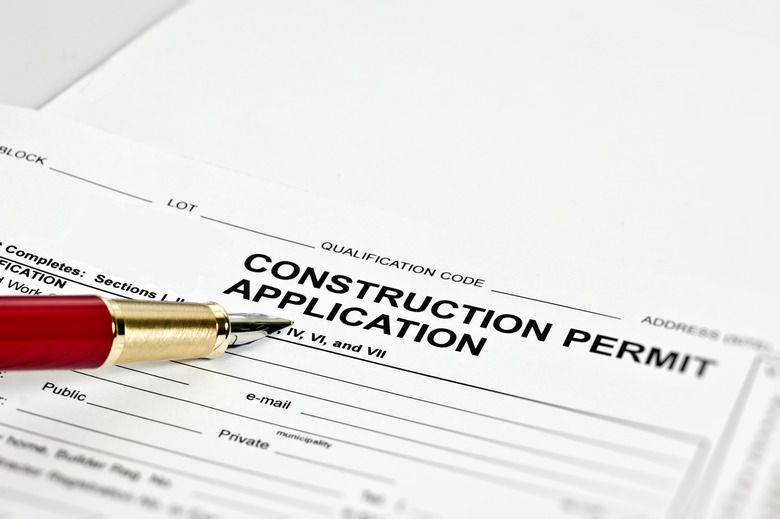When Do You Actually Need A Building Permit For A Remodel?
We may receive a commission on purchases made from links.
There's only one way to know for sure if you need a building permit for your home repair or improvement project: Call your community's building inspection office, describe the project you have in mind, and ask if a permit is needed. The permit requirements can vary enormously from state to state and even from community to community within the same state, so there's no substitute for reaching out to the inspections office for information specific to your community.
Some communities are very lenient in what they allow a homeowner to do without a building permit, while others are much more cautious, requiring permits for all but the most basic repairs and replacements. All permitting for construction, landscaping, and mechanical projects occurs at the local level, though the official requirements are often taken from some type of national model code, such as the National Electrical Code, the International Building Code, or the International Plumbing Code.
Unsure if your upcoming home project or renovation requires pulling a permit? Here's what you need to know.
Tip
Permit requirements vary from state to state and community to community. Generally, building permits are required for most projects that change or add to a home. They are not usually required for repairs and replacements.
What Is a Building Permit?
What Is a Building Permit?
The term "building permit" refers to the official permission that is granted by a community's officials to a contractor or homeowner who wishes to complete a construction or remodeling project. Permits are necessary only for work that is governed by the community's official codes, not for routine maintenance or repair work. In other words, you'll be required to apply for a permit if you are installing new plumbing for a new or remodeled bathroom but not if you are just replacing the faucet or toilet in an existing bathroom.
In reality, there are several different codes that play a role, and it's possible that the required permits may be issued by different governmental offices. Your community may enforce an overall building code, a plumbing code, a wiring code, and an HVAC code as well as a basic zoning code. A large project, such as a room addition, might require several permits: a zoning permit, a building permit, a wiring permit, and a plumbing permit.
Zoning ordinances dictate how a property can be used, and zoning approval is required whenever your project changes the basic footprint of a home or when you change the way the home or yard is used. For example, a zoning permit is often required when building certain fences or a garage or large shed or when adding an in-ground swimming pool to your property. In some communities, a zoning permit may be required in addition to whatever construction or mechanical permits are needed, but in other areas, the zoning and building permits are issued simultaneously based on a single application.
To determine what type of permit is needed, which code applies, and where to apply for it, a simple online search using a search term like "building permits for [city name]" will steer you to where you need to go.
Why Permits Are Necessary
Why Permits Are Necessary
The permitting process exists so community officials can ensure that residential construction and mechanical work is done in a manner that is safe for you and for any future residents of your home. Permits are virtually always issued with the requirement that the work must be inspected by a qualified person employed by the permitting agency. Various inspectors knowledgeable about different elements of construction are retained by the municipality to review the work done on a home or landscape and sign off to verify that the work is up to code.
Whoever applies for the permit, homeowner or contractor, is generally responsible for calling the city inspection office and arranging for an inspection at the appropriate stage of the construction process. It's not uncommon for some projects to require two inspections — one at the rough-in stage (when wiring cables and plumbing pipes are installed, for example) and one final inspection when all fixtures are installed.
DIYers and the Permit Process
DIYers and the Permit Process
Building permits are usually secured by the general contractor who is handling subcontractors, or individual contractors (such as plumbers, electricians, or deck builders) may obtain permits for small projects. When a homeowner is serving as their own general contractor and hiring hourly workers to complete the work, it is often the homeowner who pulls the permits. Any homeowners who are completing the work themselves will of course be responsible for securing any necessary permits and arranging for the proper inspections.
While permits are often issued rather automatically for experienced contractors who have a track record with the city inspection office, the application process may be much more detailed when a DIY homeowner applies for a permit. As a DIYer, you can expect the office to ask questions and perhaps ask to see your written plans for the project. With highly technical projects, such as wiring electrical circuits, the permitting office may even require that you demonstrate your competence by taking a brief test or answering some technical questions. Such screenings aren't very difficult, and most homeowners with modest experience and understanding have no problem passing them.
For simple projects, the permitting process may require just a single visit to a municipal office, but with more complicated home improvement projects, the process may involve several steps:
- Complete a permit application.
- Create a site plan for the project, possibly with the help of an architect.
- Schedule an appointment to have your plans reviewed and approved. Sometimes, this can happen on the spot at the inspections office, or it may take the office several days or even weeks to review and approve your plan.
- Pay for the permit.
- Do the work and then schedule an inspection. Some projects may require multiple inspections at different phases of completion.
- Obtain final approval from the permitting office, thereby closing the permit. It is usually the responsibility of the homeowner or contractor to call the office and initiate the closing process; the inspector's approval does not automatically close the permit.
You can anticipate that the inspection will be a bit more detailed when the inspector is reviewing the work of an amateur. Some inspectors barely walk through a project that has been completed by a contractor they know well, but they look quite carefully at DIY work. This is exactly the way it should be, as the goal is to make sure the work is safe. Treat the inspector as a source of valuable help, not an obstacle or foe.
Projects That Usually Require Permits
Projects That Usually Require Permits
A general rule of thumb is that building permits are needed for any project that changes the use of your home or any of its mechanical systems. Any project that makes a change to the footprint of your home or alters its electrical, plumbing, or HVAC system will require a permit, as will many landscaping projects. Some projects that usually require permits include:
- Windows or doors that require new openings
- Water heater replacement (venting will be carefully scrutinized)
- Fences above a certain height (usually 6 or 7 feet)
- Adding an attached deck or porch
- Replacing roofing or siding
- Adding an underground irrigation system
- Adding, moving, or extending electrical circuits, plumbing lines, or gas lines
- Adding or changing HVAC ductwork
- Major kitchen or bathroom remodel involving changes to layout, plumbing, or wiring
- Making changes or additions to load-bearing walls, decks, balconies, and porches
- Building a new driveway, patio, or sidewalk
- Building a backyard shed or gazebo with a permanent foundation
- Demolition of an existing building or landscape feature (garage, large shed, swimming pool)
- Building a tall (more than 4 feet) retaining wall or freestanding garden wall with a foundation
- Building an in-ground pool
- Replacing or moving a furnace, A/C unit, or heat pump
- Altering room use (converting a garage to a bedroom, for example)
- Removing or altering load-bearing walls
- Building a room addition
Projects That Usually Don't Require Permits
Projects That Usually Don't Require Permits
Projects that involve simple repair or replacement of existing fixtures or construction usually don't require building permits. Some examples include:
- Painting and wallpapering
- Replacing flooring
- Replacing countertops
- Replacing existing plumbing fixtures
- Window or door replacements or inserts
- Installing low-voltage landscape lights
- Doing minor electrical work and replacements (light fixtures, outlets, switches, etc.)
- Replacing cabinets
- Laying carpet
- Replacing existing appliances
- Installing window air conditioners
- Repaving existing driveways or sidewalks
- Repairing a sprinkler system
- Building short fences (under 6 or 7 feet)
- Building a small, freestanding shed or deck
- Building short (under 4 feet tall) retaining walls
Remember that there is no hard and fast rule for what projects require permits. Your community may be much more strict (or lenient) in its requirements.
Who Pays for the Permit?
Who Pays for the Permit?
If you have hired a contractor, they will usually apply for the permit and include its cost in the bid they quote you. This isn't always the case, but if a contractor expects you to apply for the permit and arrange for the inspection, you should be told this up front.
If you are performing the work as a DIYer, then you will be responsible for applying for any required permits and paying their cost. Permit costs are sometimes calculated as a percentage of the total estimated construction cost of the project. Some communities, for example, charge a flat 1 percent of the estimated project cost.
Permit costs can vary widely from community to community. National statistics show that average permit costs for a major project, such as converting a garage, range from $1,200 to $1,500, while the permit costs for building a fence can be as little as $20 to $60. In general, permit costs are lower in small cities and towns than they are in large cities.
Consequences for Skipping the Permit
Consequences for Skipping the Permit
Unfortunately, it's all too common for homeowners to skip the permitting process in an effort to save money and avoid the hassle of inspections. This is a very bad idea that can lead to problems ranging from expensive inconvenience to flat-out tragedy.
When it comes time to sell your home, if it comes to light that there have been home improvements done without proper permits and inspections, it can grind the entire process to a halt as you are forced to get the work inspected after the fact — and probably pay a significant fine. It's possible you will even need to tear out the work and redo it to meet code requirements.
Similarly, attempts to refinance your home may meet a dead end if the property assessment exposes that there have been improvements made without proper permits. When a loan assessor processing a refinance application calculates square footage that exceeds the listed size on the previous mortgage, for example, city officials often catch homeowners who have bypassed the legal permitting process, or a new roof that's not linked to a building permit can prompt investigation by the city inspections office.
DIY plumbing or wiring work that is done improperly can lead to near total destruction of a home — a tragedy that can be avoided by the simple process of pulling a permit and having the work inspected. A home disaster, such as a fire or plumbing leak, that is traced to work done without proper permits and inspections may cause your insurance company to contest your claim.
While the building permit and inspection process may seem like an expensive inconvenience, the consequences of bypassing the system can be infinitely more inconvenient, more expensive, and often dangerous. Pulling the required permits for remodeling work is always the best plan.



